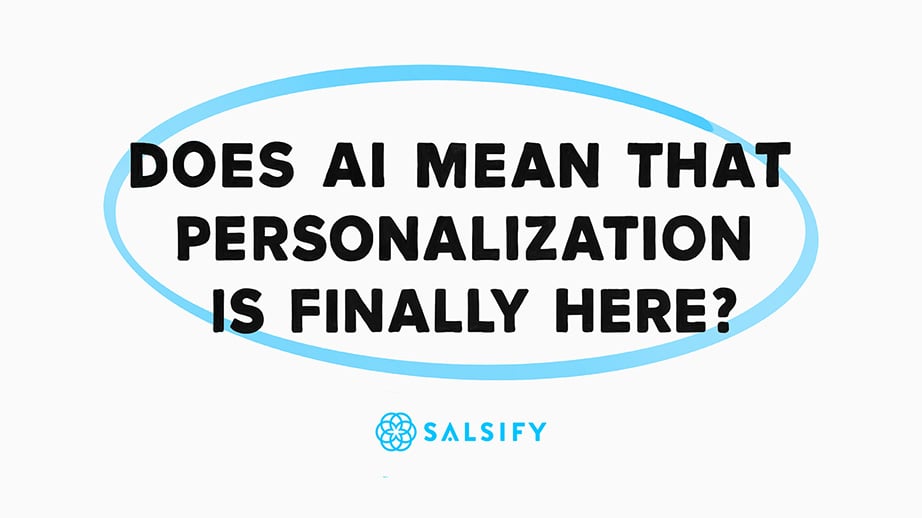Hi. I'm Rob from Salsify, and I'm back at the whiteboard to talk about how, and how much, AI will change shopping. And, unsurprisingly, I think it's going to change it quite a bit. And I'll tell you why. I'll tell you why I think this. I think that we're entering a new era of shopping.
And my contention is that there's been three eras throughout history, and the eras, what defines the era, is how consumers find and interact with a product. So, in era one, when you're in the store, where the product is in the store, the shelf placement, what aisle it's in, that determines which products you're gonna see. So if you're looking for noodles and you go to the new noodle aisle, what products are there? And then, you've got the packaging.
That's how you kind of down select. You're looking at various products, you're looking at the packaging and all this sort of stuff. And to support that, there's all kinds of people, processes, and technologies that make this world work, working backwards from the packaging on the shelf. Like retailers are doing merchandising, and you've got things like product photography and planograms and circulars for advertising and all this sort of stuff, all in support of this first era. The second era, of course, is ecommerce, which we all know and love in this world, and we're going to be talking a little bit more about how that works in a second.
And search and the product detail page are the ways that you find and select products in the era of ecommerce. And in AI shopping, this is the first time since ecommerce, where the means, the experience of finding and selecting a product, is new. No longer are you using search. No longer are you looking at product detail pages. You're doing everything within a chat, or, in the future, maybe delegating to an agent to complete everything for you. And that's different. The whole experience of shopping is different. That's what makes AI shopping new.
This isn't like when people were talking about live shopping with videos, or social commerce, or whatever. Those weren't new methods of shopping. Those were all kinds of ecommerce. AI is different because the experience is different.
So let's go back to era two for a second, just to get a sense of how this is going to shake things up. In era two, the first thing you do is you search for a product. In 2000, I worked for a company called Endeca Technologies that did enterprise ecommerce search. They were the search engine for Walmart.com, for example. They were awesome.
So if I search for like “Best makeup for bald heads,” what's gonna happen is you're gonna do search, and it's gonna take you to a search engine results page, a SERP.
And we all know the search engine results page. It's a combination these days of paid for products, for retail media listings or organic search results. And then from there, you kind of, you know, if you're in Chrome or something, you might open a bunch of different tabs. But anyway, you go to different product detail pages and you figure out which one is for you. You read the reviews, you look at the pricing, and availability, yada, yada, yada, right? So we all know this three-step process. Now, what's kind of interesting about this is there are almost three different pages here, right?
In AI, you're just in one place. You're just in the chat. You never leave the chat, right?
So what ChatGPT has been talking about, and what they announced on their site, is you go in the chat, you're doing the search for products. It's showing you summaries of what the products are and the prices and whatnot, and what their aspiration to do is to actually complete the entire shopping experience without ever leaving ChatGPT.
So you are in the chat the entire time, from beginning to end. This is also going to be true if you go to an experience from Walmart, or from Amazon, or Home Depot. They're going to allow you to do the entire process from within the chat. This means that you're not going to the product detail page, you're not seeing the feature bullets, you're not seeing the enhanced content, you're not seeing the videos.
Like, you might ask for those things as part of the chat, but by default, they're not there. There's other questions about how are these products selected. When you do kind of quote a search in the chat, how does it make the decision as to which ones to even show you, right?
So this is kind of interesting. It's a radically different experience with radically different technologies. And just like era one and era two had different people, processes, and technologies that built around them in order to support them, era three is going to as well.
Now, the next question is, how fast is this happening? I'll tell you a couple stats that show me how fast this is happening. One, you have 60% of US searches are now AI. That includes, you know, I don't know, like, a lot of people roll their eyes a little bit about this. People are going to Google, and Gemini has the search results injected into the top of Google, so they're counting that towards AI search. Fine. Right? I think the way more interesting stat is, Google gets four queries per American per day. OpenAI already has one. They're already 20% of the volume. That is insane. To go from zero to 20% of the search volume for Google is, in a very, very, very short period of time, is just radical.
That's how quick this stuff is happening. So, I think it's happening a lot faster than ecommerce. Ecommerce, for example, Amazon was founded in ‘94. We're more than thirty years into ecommerce right now. In the U.S., ecommerce penetration is under 25%, right? So it's taken 30 years to get to 25% of volume. This is crazy how fast this stuff is happening in AI.
So the question is, like, what should you do about it? If era one had people, processes, and technology supporting it, and era two had people, processes, and technology supporting that, including product experience management for your technology stack, what is era three gonna require? Everyone's trying to figure this out.
One thing that I will say is today, OpenAI, Anthropic’s Claude, Google's Gemini, they get a lot of the information about products from scraping the web, and in particular, from scraping product detail pages.
So, one thing that you can do, which helps you in era two commerce, which, you know, by the way, traditionally, commerce is not going away. It's not going to go to zero. It's still going to be an important part of the mix. So which helps you perform better in era two, while also setting you up for era three, is just make sure your PDPs are complete, because they're getting scraped by the AI bots anyway. This is the most obvious place for you to start preparing yourself for folks that are going to be using chat as their primary shopping interface.
And, what I would observe, is that there's still a lot of incomplete product detail pages that are out there. So, for example, you know, you look at this Revlon, I think, is doing a pretty good job. They have a lot of text here, in short sentences, with value propositions.
AI is going to be scraping this and ingesting that. You see a lot of people with maybe shorter feature bullets that don't have as much information. A lot of humans don't necessarily read these things. AI is reading all of them.
It's a chance for you to jam in more information about your products. There's all kinds of opportunities to jam more information about your products on these pages that people are not taking advantage of. There's also, like in terms of information you can jam in, Rufus is giving you hints as to what people are asking for, right?
So if you look at your product detail page, for example, and Rufus is saying, “Does it have a matte finish,” and the product detail page doesn't answer that question, you know, that's a hint that you should put that answer somewhere on the page, because it will help the AI systems list your product when people are asking questions that are relevant to it, right?
So there's a lot that you can start doing about it. We've got a new whitepaper that's out there that goes into more detail about what other things you could do about it. However, I will just say that this is not, you know, a known solve at this point. This is an extremely fast moving, extremely emergent field.
Lots of people are trying to figure it out. At the whiteboard, we're gonna be keeping you apprised of new things that we learn as the world changes. So, thank you.




.svg)